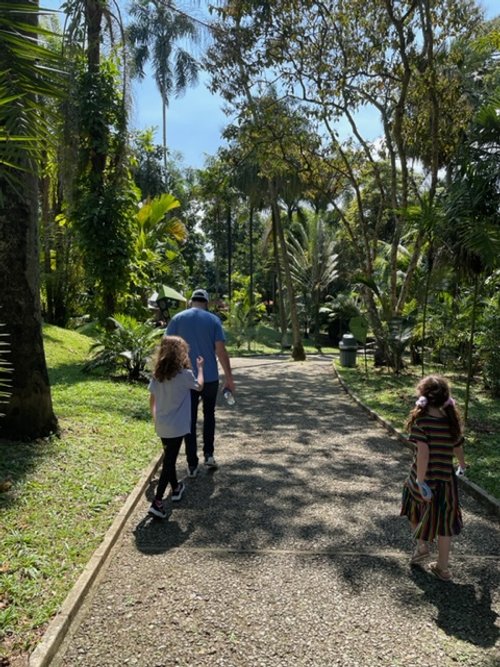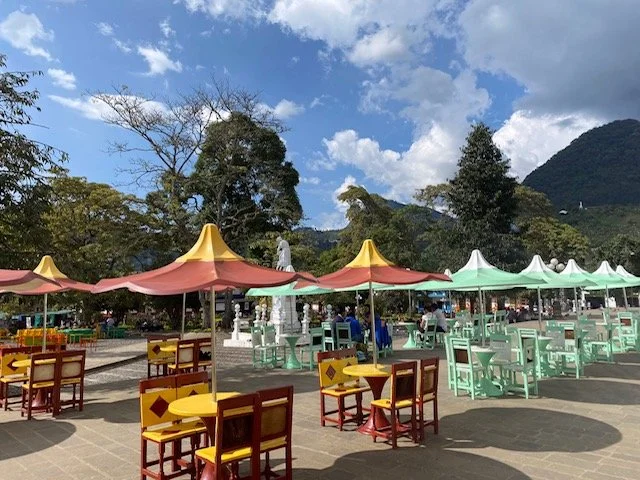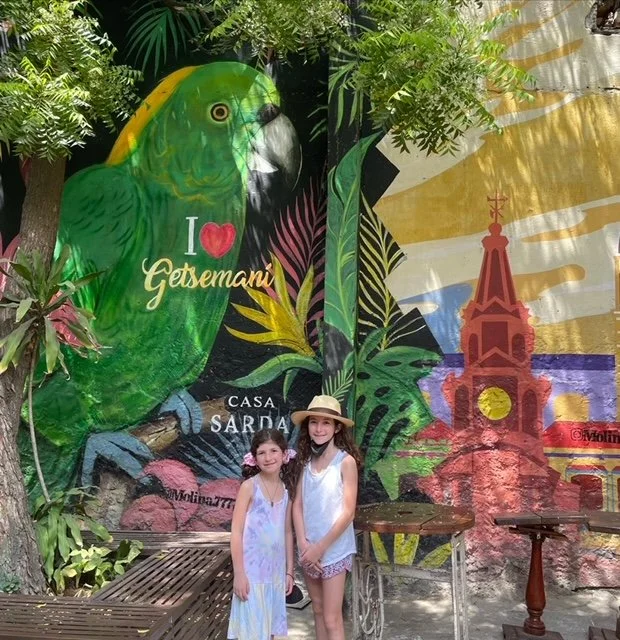Ten Days in Colorful Colombia!
/We spent 10 days in Colorful Colombia. Traveling to this country has been high on my list ever since our girls’ amazing former nanny shared stories of her home country's beauty with us. Colombia is also quite an easy foreign travel destination - it’s quite a short plane ride and there is little to no time difference (depending when you go).
During our trip, we hit Medellín - an urban city in the process of revitalization, Jardín - an absolutely charming coffee farming community and Cartagena - a Caribbean beach destination extremely popular with US tourists.
Medellín Is a City of Disparities
Colombia is unfortunately known for its socioeconomic inequality and the disparity between wealth and poverty is very much on display in Medellín. What was not long ago considered one of the most dangerous cities on earth (see: Narcos), Medellín today wins awards for its innovation. And while the city’s revitalization is amazing, it’s quite clear that not all barrios are moving at the same upward speed.
Poblado is the upscale and very tourist friendly barrio of Medellín where we stayed and where most US tourists would stay. This area is a mix of elegance and party vibes. It’s safe to walk around here and it’s where you’ll find the most - but still limited - English speaking (English is not widely spoken in Medellín or Jardín). Like most of Medellín, Poblado is bustling with action - motorcycles, hip hop street performers, party goers all whizzing by you as you walk the streets.
Our boutique hotel, Hotel Du Parc, was lovely and located on a quiet block in Poblado but very close to Parque Lleras, THE nightlife hotspot of Medellín. Other hotels in the barrio are surely quieter than ours was, but I loved our hotel’s Colonial elegance and how close it was to the action.
Speaking of that action, there are lots of restaurants (don’t miss Hatoviejo for traditional Colombian food and Cafe Zorba for surprisingly great pizza and vibes) and bars in Poblado. It’s happening!
Laureles is another upscale, albeit more residential, barrio of Medellín that we quite enjoyed walking around for a few hours one day.
In stark contrast to these trendy and upmarket areas, other parts of Medellín are still very poor, in bad condition and not recommended for tourists. El Centro is one such area that is rather rough but still must be visited by tourists to view the MUST SEE Fernando Botero sculpture park. The sculptures are stunning but alas El Centro is quite shady, especially with kids in tow, so we viewed the sculptures fast and then left.
The poorest barrio of Medellín, Comuna 13, once a danger zone is today another of the city’s MUST SEE areas. In the 80s and 90s, violent drug trafficking organizations made this poverty stricken remote hillside area into a transit route to pass guns, drugs and money in and out of the city. Eventually, the Colombian government set about improving the hillside commune, including installing a series of 6 outdoor escalators in 2011 connecting parts of the once chaotic and isolated hillside neighborhood to the rest of the city below.
Feeling newly optimistic, residents took to the walls creating murals to tell Comuna 13’s history, beautifying the area and bringing optimism and peace to residents, children and visitors. Comuna 13 is still a very poor, secluded and downright daunting area of Medellín so tourists should go with a local tour group. We were so lucky to tour with Laura of Zippy Tours. Born and raised in the commune, Laura was so forthright about her community’s dark past and proud of where it is today. This tour was so memorable.
And if you are in Medellín with kids, consider taking them to Parque Explora (a very modern, hands-on science museum) and the Botanic Garden right next door. Our girls also enjoyed our visit to Santa Fe, a modern, American style mega mall.
We did not make it to Parque Avrí, nor did we get to experience Medellín’s impressive cable car public transportation system on this trip.
I’m so curious whether Medellín will continue on its path toward revitalization. The city is already attracting young “digital nomads” with its cosmopolitan barrios and low prices (USD goes very far in Medellín!)
Jardín Is Magic
I will never forget Jardín. This small Andean municipality is known for its brightly colored Colonial architecture, its beautiful flower and plant life and its absolute VIBE that is sitting in the town’s main square relaxing over a cup of coffee.
We hired a (lovely!) driver to take us roughly three hours from Medellín to Jardín and it was so, so worth the fairly arduous, remote drive. This is a special, authentic Colombian coffee farming town unspoiled by tourism or modernization. It is a place to relax and slow down time. It’s a place to appreciate natural beauty and the simple pleasure of a good cup of coffee. This is small, remote town living.
We LOVED our stay at four year old Casa Passiflora Hotel Boutique. It is so beautiful and well appointed. The staff is lovely, there’s a nice little onsite restaurant and a perfect hot tub and sitting area out back. Jardín is small, but even still, Passiflora is perfectly located two blocks from the main square.
As coffee vibes are huge in Jardín, a wonderful place to soak them up is at Café Jardín, a beautiful coffee shop, restaurant and bar 10 minutes from town center heading up the mountain. This café serves up views and vibes that rival its delicious home grown coffee and house-made pastries. It’s just stunning.
We also had nice coffee and a solid Instagram session at Café Macanas in the main square. Note that (i) simply grabbing a cup to go is a pretty foreign concept in Colombia and especially in Jardín, where the norm is to just sit with a cup and your thoughts for hours and (ii) the food in Jardín is sadly pretty much universally terrible. If it were better, I’d probably move there tomorrow lol!
Besides sipping coffee, there are several hikes and waterfalls to check out in Jardín. And I loved visiting the Parque Natural Jardín de Rocas to ogle over the bright red male Andean Cock of the Rock birds that live there.
Jardín made for a relaxing and breathtaking pit stop between cosmopolitan city Medellín and tourist inundated Cartagena. We truly loved it.
Cartagena Es Muy Popular
I knew Cartagena would be more tourist friendly than our other two stops, but arriving there frankly blew our mind. After days of speaking Spanglish and experiencing authentic Colombian culture, Cartagena felt sort of like visiting any other Caribbean destination. Americans and English are everywhere and the Walled City, where most tourists stay, is crawling with tourists and Colombian merchants pushing their merch on said tourists.
There are many gorgeous restaurants and boutique hotels in the Walled City and we had some nice meals and shopping excursions while in Cartagena, but this was our least favorite of the three locations. It’s too touristy for us.
Cartagena is also best for adults. Our kids loved splashing around in our lovely hotel’s pool (Hotel Qudrofolio) but on a whole, the vibes in Cartagena are undeniably adult (and young adult). It’s all about getting decked and getting drunk in Cartagena. Think South Beach meets Mykonos meets Times Square.
The best activity we did in Cartagena was a morning spent meandering through Getsemaní, the “hipster” and far more authentic barrio of Cartagena. The street art and streets themselves here are bursting with color and excitement.
On our last day in Cartagena, we did a day pass to a beach hotel in Isla Tierra Bomba (about 30 minutes by boat from the city). The day started off great but gradually got more crowded with more drunk tourists enjoying bottle service and techno music. Sort of like the Walled City itself, this beach day was not geared toward families or folks who are no longer interested in bottle service pool party vibes a la Miami or Vegas.
Cartagena is truly a Caribbean destination and not all that different from the islands you’ve already visited there. But there’s an enchanting atmosphere within the narrow streets and Colonial architecture of the Walled City - it is, after all, a UNESCO world's heritage site - and with the swarms of American tourists, the destination emotionally feels closer to home than Medellín or Jardín. It’s only 2.5 hours from Miami!
And we had some nice meals in town. Cartagena is a heaven for ceviche and cocktail lovers like myself (don’t miss Restaurante Cancha). We also had a great breakfast at Epcoa Cafe and a surprisingly nice Italian meal at Trattoria Wippy.
**
Altogether, we had ten wonderful days in Colombia. The country exudes warmth and vibrancy and it’s amazing to see a country once considered too dangerous for travel turn itself around and welcome tourism.
Muchas gracias, Colombia!






































































